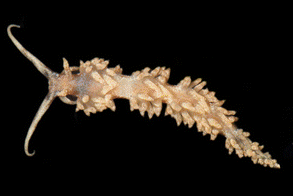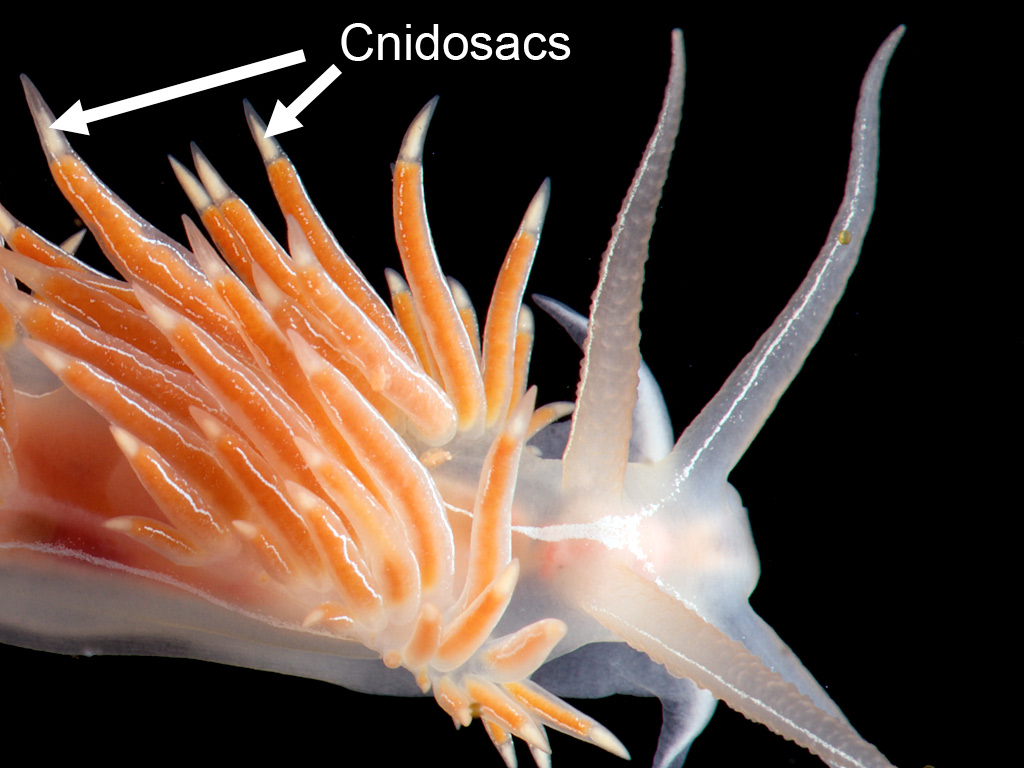|
Palisa
''Palisa papillata'' is a species of sea slug, specifically an aeolid nudibranch. It is a marine gastropod mollusc in the family Facelinidae. It is the only species in the genus ''Palisa''. Distribution Distribution of ''Palisa papillata'' includes Florida, Jamaica and Panama. The holotype of this species was found at Port Royal, Jamaica and a specimen from Miami, Florida was included in the original description.DuPont, A. (2009''Palisa papillata''JaxShells.org Description The body is elongate. Rhinophores are tuberculate. Oral tentacles are long. Cerata are arranged in clusters forming a single row along each side of the dorsum. Background color is translucent gray with numerous opaque white spots on both the dorsum and cerata. Cerata are with a pale blue digestive gland The hepatopancreas, digestive gland or midgut gland is an organ of the digestive tract of arthropods and molluscs. It provides the functions which in mammals are provided separately by the liver and panc ... [...More Info...] [...Related Items...] OR: [Wikipedia] [Google] [Baidu] |
Palisa Papillata 2
''Palisa papillata'' is a species of sea slug, specifically an aeolid nudibranch. It is a marine gastropod mollusc in the family Facelinidae. It is the only species in the genus ''Palisa''. Distribution Distribution of ''Palisa papillata'' includes Florida, Jamaica and Panama. The holotype of this species was found at Port Royal, Jamaica and a specimen from Miami, Florida was included in the original description.DuPont, A. (2009''Palisa papillata''JaxShells.org Description The body is elongate. Rhinophores are tuberculate. Oral tentacles are long. Cerata are arranged in clusters forming a single row along each side of the dorsum. Background color is translucent gray with numerous opaque white spots on both the dorsum and cerata. Cerata are with a pale blue digestive gland and characteristic black or dark brown spots at the base. The maximum recorded body length is 15 or 16 mm.Welch J. J. (2010). "The “Island Rule” and Deep-Sea Gastropods: Re-Examining the Evidence". ... [...More Info...] [...Related Items...] OR: [Wikipedia] [Google] [Baidu] |
Facelinidae
The Facelinidae are a Taxonomy (biology), taxonomic family (biology), family of colorful sea slugs. These are specifically aeolid nudibranchs. They are marine (ocean), marine gastropod molluscs.Bouchet, P. (2012). Facelinidae. Accessed through: World Register of Marine Species at http://www.marinespecies.org/aphia.php?p=taxdetails&id=191 on 2012-07-22 Taxonomy 2005 taxonomy This family consists of the following subfamilies (according to the Taxonomy of the Gastropoda (Bouchet & Rocroi, 2005), taxonomy of the Gastropoda by Bouchet & Rocroi, 2005): * #Facelininae, Facelininae Bergh, 1889 - synonyms: Caloriidae Odhner, 1968; Phidianidae Odhner, 1968; Pruvotfoliinae Tardy, 1970 * Babakininae Richard A. Roller, Roller, 1973 - synonym: Babainidae Roller, 1972 (inv.) * #Crateninae, Crateninae Bergh, 1889 - synonym: Rizzoliinae Odhner, 1939 (inv.) * #Favorininae, Favorininae Bergh, 1889 - synonyms: Myrrhinidae Bergh, 1905; Phyllodesmiinae Thiele, 1931; Facalaninae Er. Marcus, 1958 * ... [...More Info...] [...Related Items...] OR: [Wikipedia] [Google] [Baidu] |
Port Royal
Port Royal is a village located at the end of the Palisadoes, at the mouth of Kingston Harbour, in southeastern Jamaica. Founded in 1494 by the Spanish, it was once the largest city in the Caribbean, functioning as the centre of shipping and commerce in the Caribbean Sea by the latter half of the 17th century. It was destroyed by an earthquake on 7 June 1692, which had an accompanying tsunami, leading to the establishment of Kingston, which is now the largest city in Jamaica. Severe hurricanes have regularly damaged the area. Another severe earthquake occurred in 1907. Port Royal was once home to privateers who were encouraged to attack Spanish vessels, at a time when smaller European nations were reluctant to attack Spain directly. As a port city, it was notorious for its gaudy displays of wealth and loose morals. It was a popular homeport for the English and Dutch-sponsored privateers to spend their treasure during the 17th century. When those governments abandoned the prac ... [...More Info...] [...Related Items...] OR: [Wikipedia] [Google] [Baidu] |
Jamaica
Jamaica (; ) is an island country situated in the Caribbean Sea. Spanning in area, it is the third-largest island of the Greater Antilles and the Caribbean (after Cuba and Hispaniola). Jamaica lies about south of Cuba, and west of Hispaniola (the island containing the countries of Haiti and the Dominican Republic); the British Overseas Territory of the Cayman Islands lies some to the north-west. Originally inhabited by the indigenous Taíno peoples, the island came under Spanish rule following the arrival of Christopher Columbus in 1494. Many of the indigenous people either were killed or died of diseases, after which the Spanish brought large numbers of African slaves to Jamaica as labourers. The island remained a possession of Spain until 1655, when England (later Great Britain) conquered it, renaming it ''Jamaica''. Under British colonial rule Jamaica became a leading sugar exporter, with a plantation economy dependent on the African slaves and later their des ... [...More Info...] [...Related Items...] OR: [Wikipedia] [Google] [Baidu] |
Animal
Animals are multicellular, eukaryotic organisms in the Kingdom (biology), biological kingdom Animalia. With few exceptions, animals Heterotroph, consume organic material, Cellular respiration#Aerobic respiration, breathe oxygen, are Motility, able to move, can Sexual reproduction, reproduce sexually, and go through an ontogenetic stage in which their body consists of a hollow sphere of Cell (biology), cells, the blastula, during Embryogenesis, embryonic development. Over 1.5 million Extant taxon, living animal species have been Species description, described—of which around 1 million are Insecta, insects—but it has been estimated there are over 7 million animal species in total. Animals range in length from to . They have Ecology, complex interactions with each other and their environments, forming intricate food webs. The scientific study of animals is known as zoology. Most living animal species are in Bilateria, a clade whose members have a Symmetry in biology#Bilate ... [...More Info...] [...Related Items...] OR: [Wikipedia] [Google] [Baidu] |
Mollusc
Mollusca is the second-largest phylum of invertebrate animals after the Arthropoda, the members of which are known as molluscs or mollusks (). Around 85,000 extant species of molluscs are recognized. The number of fossil species is estimated between 60,000 and 100,000 additional species. The proportion of undescribed species is very high. Many taxa remain poorly studied. Molluscs are the largest marine phylum, comprising about 23% of all the named marine organisms. Numerous molluscs also live in freshwater and terrestrial habitats. They are highly diverse, not just in size and anatomical structure, but also in behaviour and habitat. The phylum is typically divided into 7 or 8 taxonomic classes, of which two are entirely extinct. Cephalopod molluscs, such as squid, cuttlefish, and octopuses, are among the most neurologically advanced of all invertebrates—and either the giant squid or the colossal squid is the largest known invertebrate species. The gastropods ... [...More Info...] [...Related Items...] OR: [Wikipedia] [Google] [Baidu] |
Digestive Gland
The hepatopancreas, digestive gland or midgut gland is an organ of the digestive tract of arthropods and molluscs. It provides the functions which in mammals are provided separately by the liver and pancreas, including the production of digestive enzymes, and absorption of digested food. Arthropods Arthropods, especially detritivores in the Order Isopoda, Suborder Oniscidea (woodlice), have been shown to be able to store heavy metals in their hepatopancreas. This could lead to bioaccumulation through the food chain and implications for food web destruction, if the accumulation gets high enough in polluted areas; for example, high metal concentrations are seen in spiders of the genus ''Dysdera'' which feed on woodlice, including their hepatopancreas, the major metal storage organ of isopods in polluted sites. Molluscs The hepatopancreas is a centre for lipid metabolism and for storage of lipids in gastropods.Böer M., Graeve M. & Kattner G. (2006). "Exceptional long-term starvat ... [...More Info...] [...Related Items...] OR: [Wikipedia] [Google] [Baidu] |
Cerata
:''The tortrix moth genus ''Cerata'' is considered a junior synonym of ''Cydia. Cerata, singular ceras, are anatomical structures found externally in nudibranch sea slugs, especially in aeolid nudibranchs, marine opisthobranch gastropod mollusks in the clade Aeolidida. The word ceras comes from the Greek word "κέρας", meaning "horn", a reference to the shape of these structures. Cerata are dorsal and lateral outgrowths on the upper surfaces of the body of these nudibranchs. Function Cerata greatly extend the surface area of nudibranchs and aid in respiration, the process of gas exchange for metabolic use. Cerata are also used, in some cases, for attack and defense. In many aeolid nudibranchs, the digestive system extends into the cerata. These nudibranchs eat stinging celled animals (Cnidarians) such as anemones, hydroids and sea fans or Portuguese men o' war. The stinging cells or nematocysts are passed unharmed through the digestive system to cnidosacs at the tips of t ... [...More Info...] [...Related Items...] OR: [Wikipedia] [Google] [Baidu] |
Rhinophores
A rhinophore is one of a pair of chemosensory club-shaped, rod-shaped or ear-like structures which are the most prominent part of the external head anatomy in sea slugs, marine gastropod opisthobranch mollusks such as the nudibranchs, sea hares (Aplysiomorpha), and sap-sucking sea slugs (Sacoglossa). Etymology The name relates to the rhinophore's function as an organ of "smell". ''Rhino-'' means nose from Ancient Greek ῥίς ''rhis'' and from its genitive ῥινός ''rhinos''. "Phore" means "to bear" from New Latin ''-phorus'' and from Greek -phoros (φορος) "bearing", a derivative of ''phérein'' (φέρειν). Function Rhinophores are scent or taste receptors, also known as chemosensory organs situated on the dorsal surface of the head. They are primarily used for distance chemoreception and rheoreception (response to water current). The "scents" detected by rhinophores are chemicals dissolved in the sea water. The fine structure and hairs of the rhinophore ... [...More Info...] [...Related Items...] OR: [Wikipedia] [Google] [Baidu] |
Miami
Miami ( ), officially the City of Miami, known as "the 305", "The Magic City", and "Gateway to the Americas", is a East Coast of the United States, coastal metropolis and the County seat, county seat of Miami-Dade County, Florida, Miami-Dade County in South Florida, United States. With a population of 442,241 at the 2020 United States census, 2020 census, it is the List of municipalities in Florida, second-most populous city in Florida and the eleventh-most populous city in the Southeastern United States. The Miami metropolitan area is the ninth largest in the U.S. with a population of 6.138 million in 2020. The city has the List of tallest buildings in the United States#Cities with the most skyscrapers, third-largest skyline in the U.S. with over List of tallest buildings in Miami, 300 high-rises, 58 of which exceed . Miami is a major center and leader in finance, commerce, culture, arts, and international trade. Miami's metropolitan area is by far the largest urban econ ... [...More Info...] [...Related Items...] OR: [Wikipedia] [Google] [Baidu] |
Holotype
A holotype is a single physical example (or illustration) of an organism, known to have been used when the species (or lower-ranked taxon) was formally described. It is either the single such physical example (or illustration) or one of several examples, but explicitly designated as the holotype. Under the International Code of Zoological Nomenclature (ICZN), a holotype is one of several kinds of name-bearing types. In the International Code of Nomenclature for algae, fungi, and plants (ICN) and ICZN, the definitions of types are similar in intent but not identical in terminology or underlying concept. For example, the holotype for the butterfly '' Plebejus idas longinus'' is a preserved specimen of that subspecies, held by the Museum of Comparative Zoology at Harvard University. In botany, an isotype is a duplicate of the holotype, where holotype and isotypes are often pieces from the same individual plant or samples from the same gathering. A holotype is not necessarily "typ ... [...More Info...] [...Related Items...] OR: [Wikipedia] [Google] [Baidu] |






